Try to name flowers that start with V, and the first thing you come up with, probably, will be “violet.” But the list also includes flowers that are violet in color but not in name, flowers that are prized for their flavor or medicinal properties, and even a violet that’s not actually a violet. Some of the stunning flowers that start with the letter V are Veronica, verbena, vetch, viper’s bugloss, Virginia bluebells, vitex, vanilla, verbascum, and valarian. Read on to find out more about the flowers that start with V.
Valerian, Valeriana officinalis
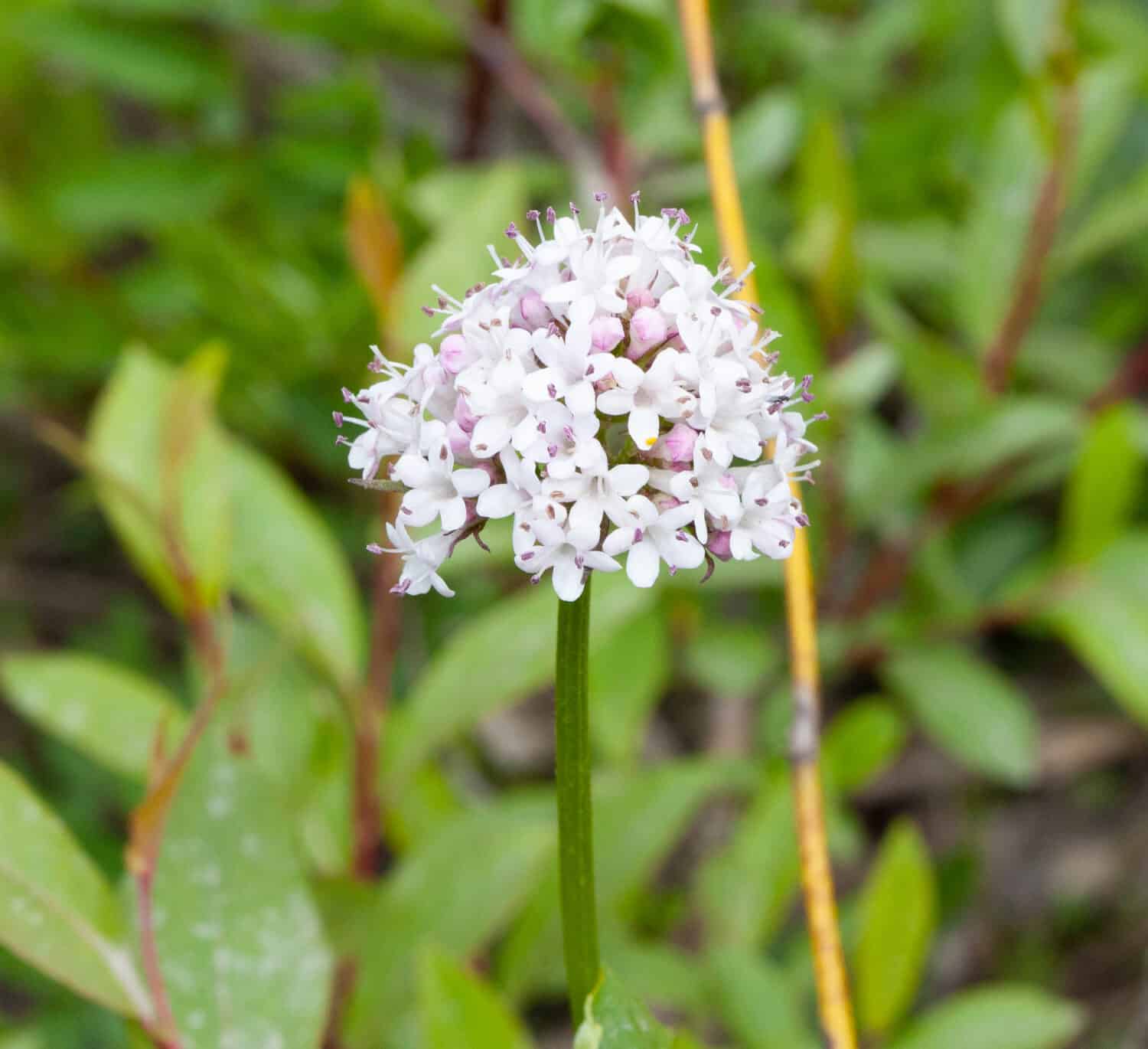
Small but mighty valerian has been prized for its healing properties.
©Melinda Fawver/Shutterstock.com
Though native to Europe and Asia, this herbaceous plant has spread to the northern U.S., where it grows wild in areas of cooler and rainier weather. In some locations, it’s considered a noxious weed. Valerian is somewhat unassuming in appearance, producing delicate, fragrant white or pink flowers atop tall (up to 5 feet) stalks. But this humble plant has a robust history of use in traditional medicine, dating back to the days of Hippocrates. In fact, one of its traditional names is “all-heal.” In modern times valerian is available in tea, capsule, or other forms as a sleep or relaxation aid. Scientific evidence for its effectiveness is inconclusive, though.
Vanilla, Vanilla planifolia
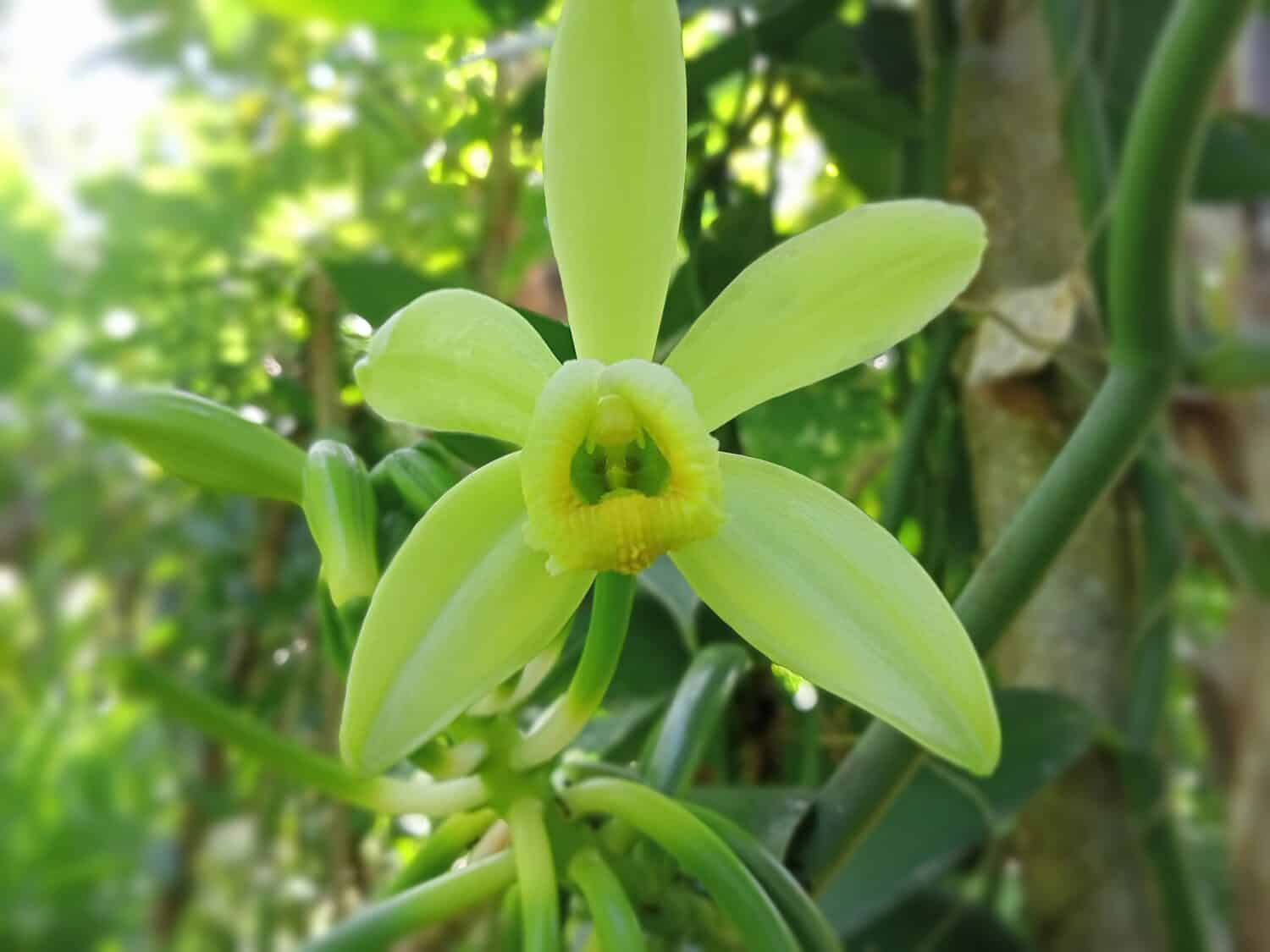
Vanilla flavoring comes from the seed pods of the vanilla plant.
©QINI ajja/Shutterstock.com
A popular component in food and cosmetics the world over, vanilla (the ingredient) comes from its namesake plant, an orchid native to the tropical forests of Mexico and South America. Vanilla was first used by the Aztec civilization as a flavoring for cocoa. Vanilla (the plant) grows as a vine that clings to trees and climbs up to 15 meters, producing greenish-to-yellow flowers. Its fruit ripens in the form of long seed pods, which are dried and cured to create the signature flavor and aroma.
Verbascum, Verbascum spp.

Verbascum can grow as wildflowers and are invasive in some areas.
©Cenz07/Shutterstock.com
Also called beggar’s blanket and mullein, the plants in this group are known for producing tall, dramatic spikes of small flowers, with large, wooly leaves at the base. Verbascum flowers can be gold, pink, purple, or white. These plants grow best in poor soil, and grow easily in average garden soil, as long as the soil has good drainage. They self-seed, so they can grow as perennials in some areas. But they can also be invasive, so check with your local agriculture extension office before planting.
Verbena, Verbena verbena

Give them plenty of sun, and verbena plants will reward you with a colorful show.
©Flower_Garden/Shutterstock.com
A great garden plant for cascading over walls, containers, baskets, or window boxes, verbena’s clusters of small flowers bloom all summer long. As long as they have eight hours of sun and well-drained soil, verbena plants can tolerate drought and remain free of pests and disease. Different varieties produce blue, pink, purple, red, or white flowers; some have fringed edges, stripes, or streaks. They last a long time as cut flowers too.
Veronica, Veronica spp.
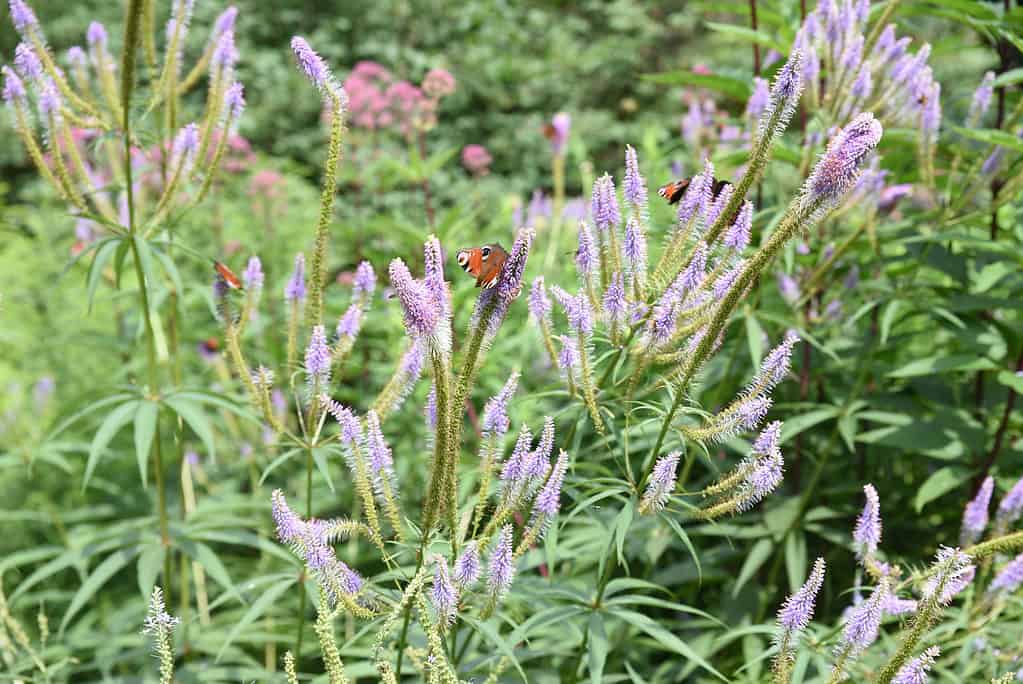
Upright veronica flowers add vertical interest to the landscape.
©photoPOU/Shutterstock.com
Also called speedwell, these flowers that start with v include hundreds of species, some of which have their own common names. Broadly speaking, veronica is cultivated for gardeners in two types. Upright veronicas produce tall, spikey flowers that are used as bedding plants and for cut flowers. Ground cover veronicas are good for rock gardens or for filling in bare spaces. Either type is generally an easy-to-grow perennial, as long as you choose a variety that matches your growing zone.
Vetch, Vicia sativa (common vetch)

Vetch species, like this hairy vetch, not only yield flowers, they add nitrogen to the soil.
©tamu1500/Shutterstock.com
Often found growing wild on grassland, farmland, and roadsides, common vetch is one of many species in the Vicia genus, all of which are legumes and related to peas (fava beans are one type of vetch). This means that these plants have the ability to enrich soil by adding nitrogen. Common vetch produces pink flowers in groups of one or two. Other vetch flowers can be magenta, white, blue, or yellow. Vetch can be planted as a cover crop, protecting and enriching soil between growing seasons.
Viburnum, Viburnum spp.

Summer snowballs: some viburnums produce globe-like flower clusters.
©luckakcul/Shutterstock.com
The diverse flowering shrubs in the viburnum genus have a lot to offer to your home garden. They produce fragrant flowers that range from white to pink and, depending on the variety, can grow in flat-topped clusters or snowball-like domes. They produce colorful berries in the fall, and their leaves turn red or orange. Some varieties will stay green in winter. They attract birds, butterflies, and other pollinators. And they’re available in sizes ranging from 3-foot shrubs to 15-foot trees. Be sure to plant them in full sun for the most blooms.
Vinca, Vinca major, Vinca minor
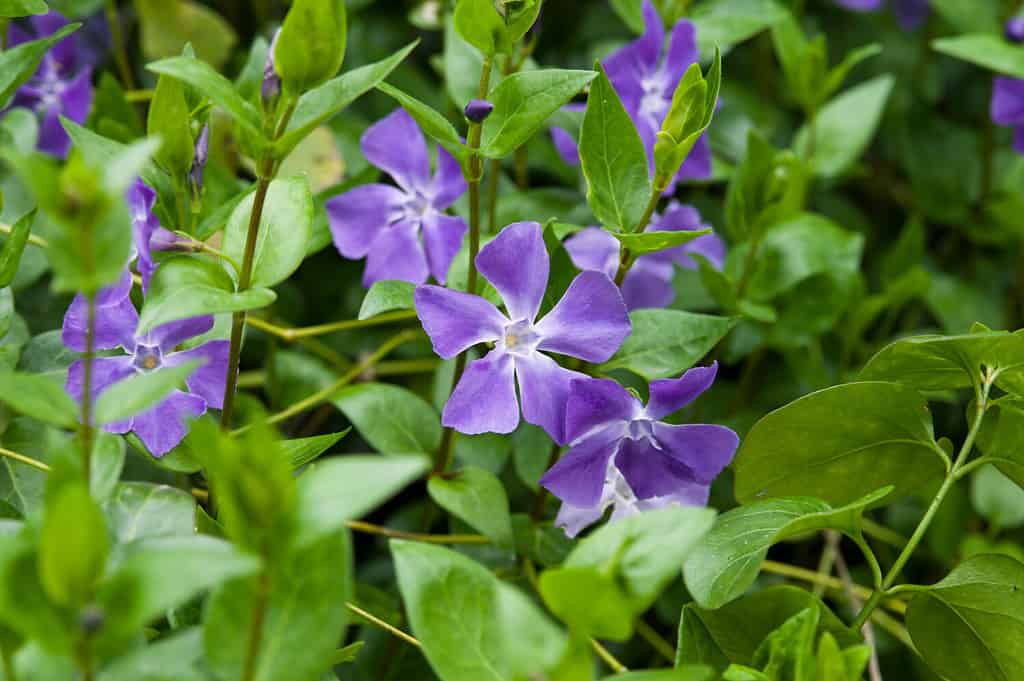
You probably know vinca by its more common name, periwinkle.
©zzz555zzz/Shutterstock.com
These flowers that start with v are low-maintenance ground-covering vines that produce small, five-petaled blue or purple flowers. You’re probably more familiar with their common names, periwinkle (Vinca minor) and bigleaf periwinkle (Vinca major, a similar but larger species). Vinca is a hardy, low-maintenance plant that grows easily in all sorts of conditions, and in warmer areas will return every spring as a perennial. In fact, both plants are considered invasive in some areas, so do your research before adding either to your landscape. You should also know that vinca can be toxic to people and pets.
Viola, Viola spp.
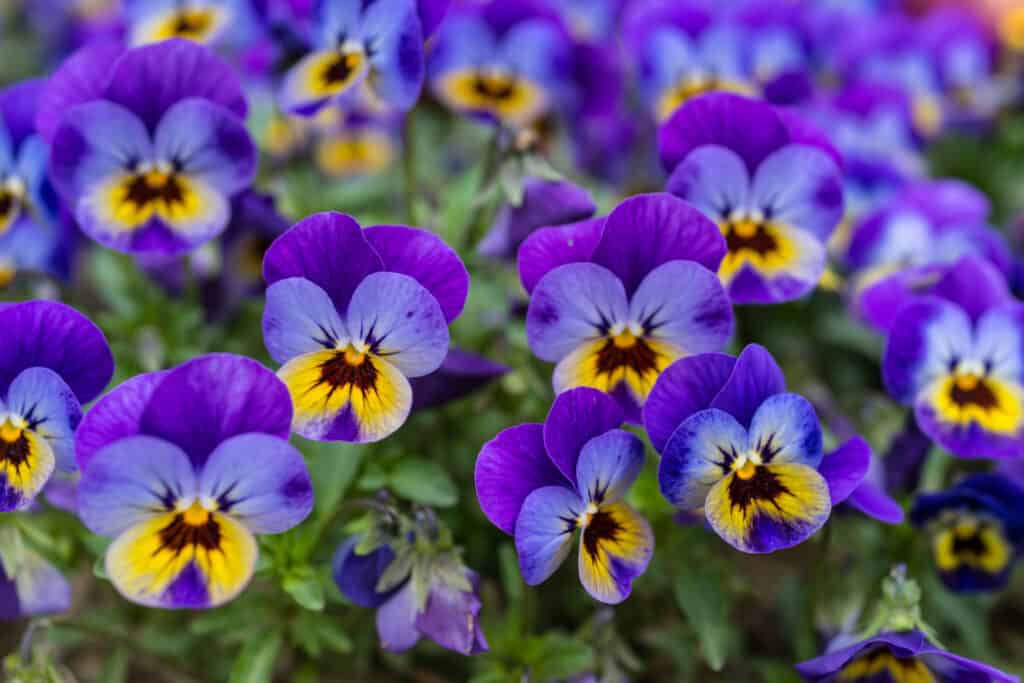
Viola species include familiar garden flowers like pansies and violets.
©eamesBot/Shutterstock.com
There are about 500 species of violas, including wild varieties that grow worldwide in meadows or woodlands. This is a widely cultivated flower, whose cultivars include familiar nursery plants like garden pansies, Johnny-jump-ups, and sweet violets. They grow flowers on single stalks with five petals; typically four are in a fan-like position. The fifth petal is a guide for pollinators. That’s significant: besides adding color to your garden, violas attract bees and butterflies, as well as songbirds. The plant’s leaves and flowers are edible and can be used in salads or other recipes (as long as they haven’t been treated with pesticides).
Violet, Viola sororia (common blue violet), Viola odorata (sweet violet)
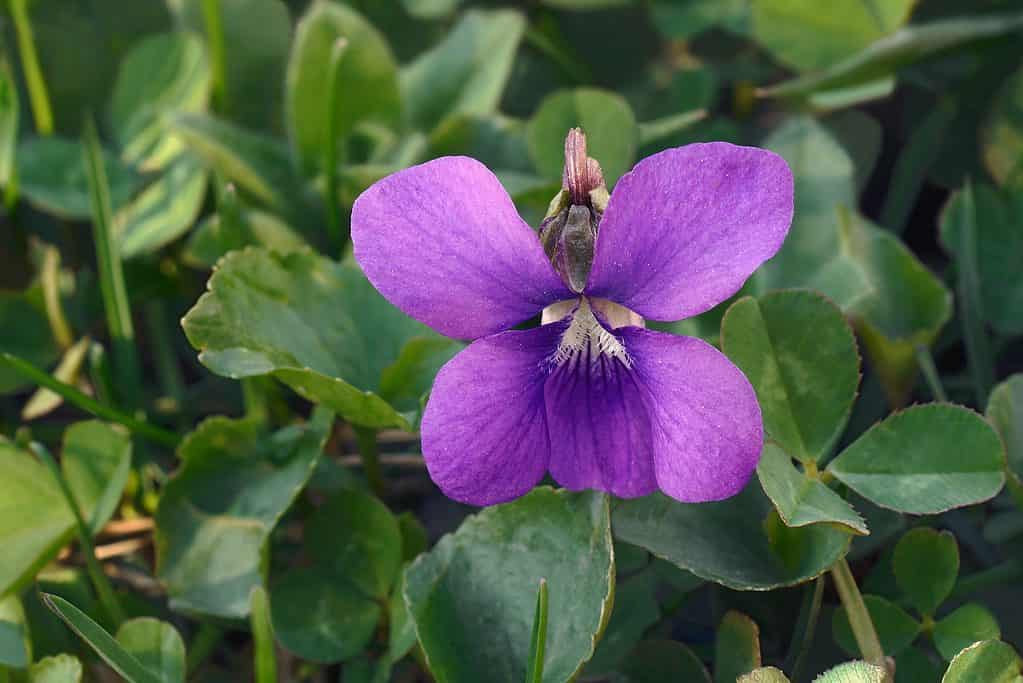
Roses are red (sometimes), violets are…um…
©Nikolay Kurzenko/Shutterstock.com
OK, stay with us. Lots of flowers have “violet” in their name. But generally when we call a flower a “violet,” we’re talking about one of the Viola species. The common blue violet, also called the wooly blue violet, is native to eastern and central north America and can be found growing wild in woods and shaded areas. Sweet violets are European natives, known for their fragrance. Many florist violets are sweet violet hybrids. It’s worth noting that despite the similar color, African violets (Saintpaulia spp.) are in a completely different taxonomic family, unrelated to “true” violets. Also, we’ll just say it: violets are more purple than blue. But “Roses are red, violets are purple” doesn’t leave much room for rhyming.
Viper’s Bugloss, Echium vulgare
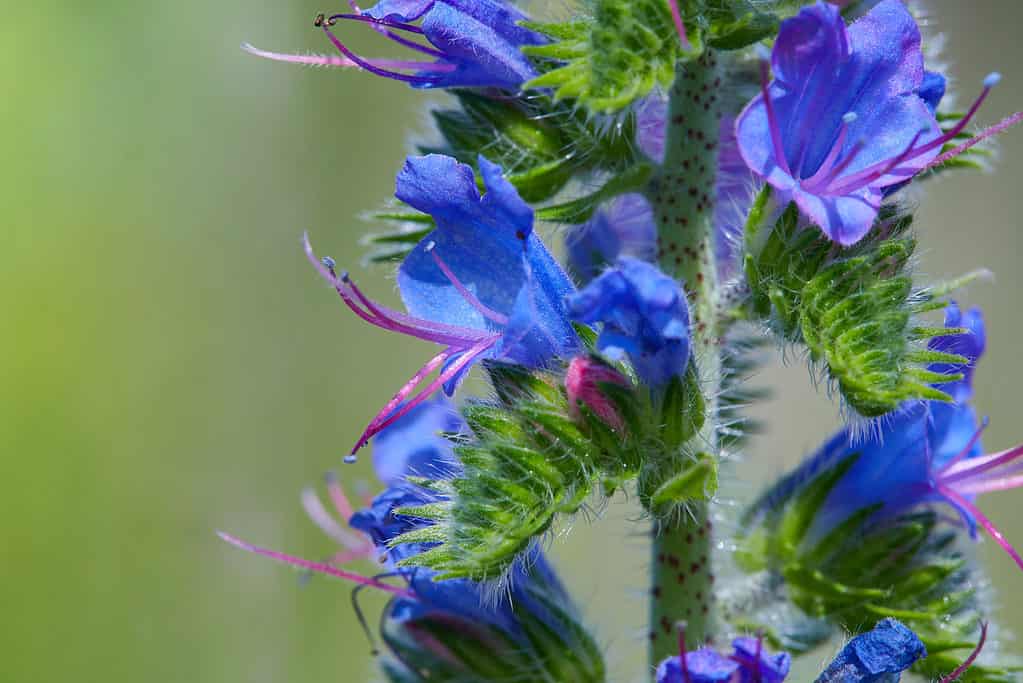
Viper’s bugloss may be a weed, but it’s worth taking a close look at.
©iStock.com/Liudmyla Liudmyla
Arguably the most strangely named plant on this list, Viper’s bugloss is a European native plant that’s considered invasive in the U.S. (as hinted at by its other common names: “blue devil,” “snake flower” and “blueweed.”). It grows as a weed in pastures, along roads, and in uncultivated areas. This is an interesting-looking plant for sure, with hairy stems and toothed, dimpled leaves. If you want to add this plant’s blue-to-purple blooms to your garden, check to see if it’s considered invasive in your area.
Virginia Bluebells, Mertensia virginica
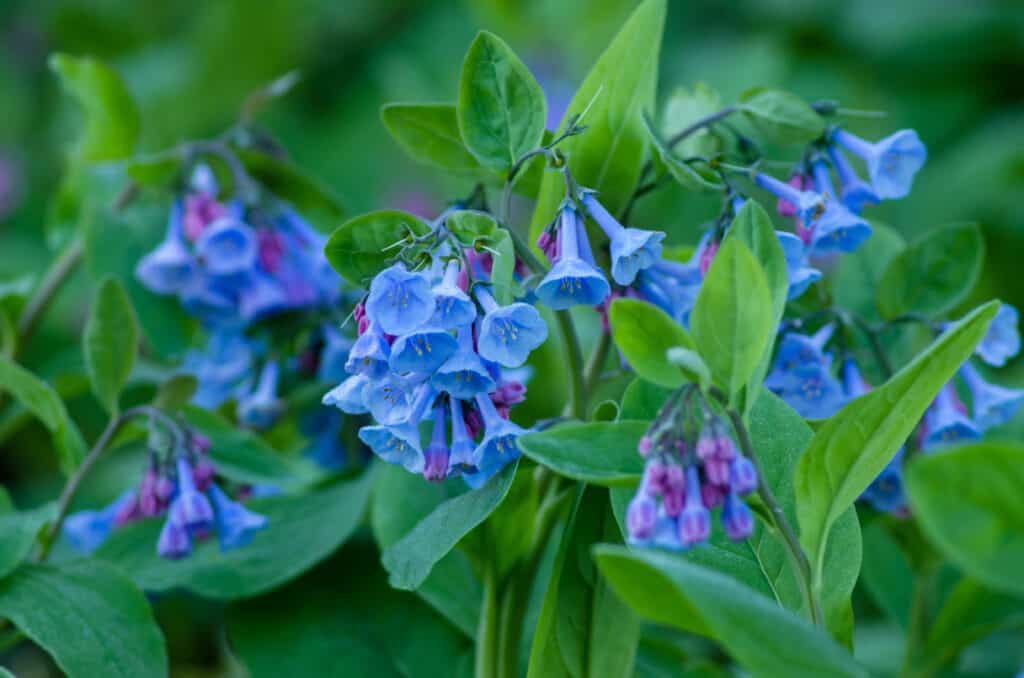
Virginia Bluebells do usually have blue flowers. However, they may have white or pink flowers as well.
©iStock.com/Joshua Moore
Native to woodlands and river areas of eastern North America, Virginia bluebells can grow as wildflowers in shaded areas. Their blue flowers are indeed bell-shaped and favored by butterflies, moths, and hummingbirds among other pollinators. They’re not favored by deer, which is one reason this plant is a good choice for landscape borders and flower beds. But be prepared for them to die off in early summer when their blooms are finished. Don’t worry, the plant has just gone dormant and will be back with bells on next spring.
Virginia Sweetspire, Itea virginica

Virginia sweetspire is colorful in the spring, and even more so in the fall.
©Kazol Anthony Das/Shutterstock.com
This easy-to-grow shrub rewards gardeners and landscapers with showy, sweet-smelling, bottle-brush-looking flowers in the spring. And then, in the fall, the sweetspire’s leaves change to red, orange, or yellow, depending on the cultivar, finishing the year with a splash of autumn color. The plant can grow in shade but produces its best blooms and colors when grown in full sun.
Vitex,Vitex agnus-castus
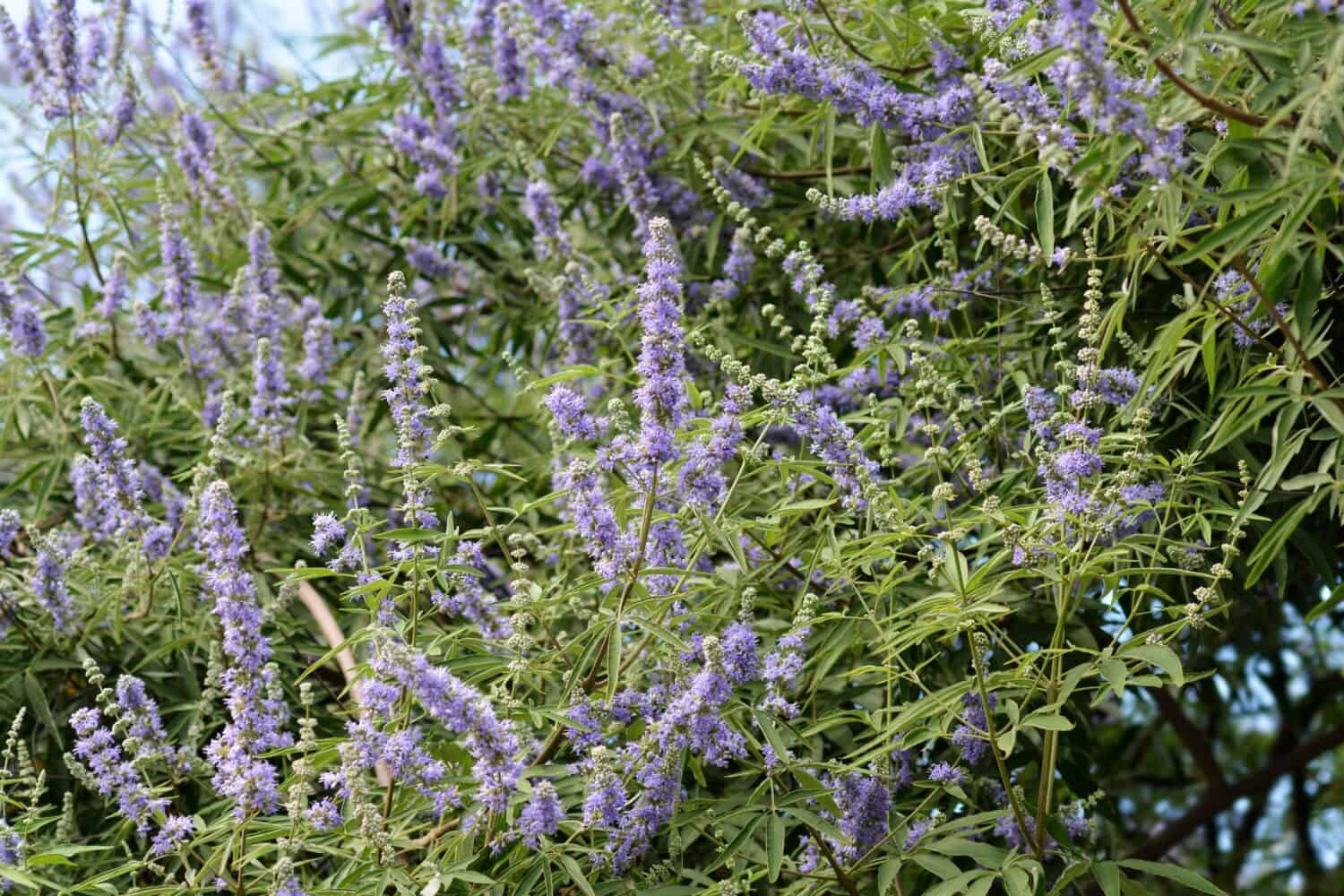
Vitex’s blooms will attract butterflies and other pollinators.
©Nahhana/Shutterstock.com
Also called chaste tree, a name that dates back to the first century AD, this shrub or small tree features green leaves with a sage-like aroma, and flowers ranging from white to pink to purple, depending on the cultivar. Its seeds and nectar attract butterflies, bees, hummingbirds, and songbirds. It’s winter-hardy and can handle summer heat and dry spells, but will benefit from pruning, and you’ll need to clean up the berries it drops in the fall. Chaste tree extracts have been used traditionally to treat menopause and menstrual symptoms, but such beneficial effects have not been proven by scientific research.
Summary: Flowers that Begin with V
| Common Name | Scientific Name |
| Valarian | Valeriana officinalis |
| Vanilla | Vanilla planifolia |
| Verbascum | Verbascum spp. |
| Verbena | Verbena verbena |
| Veronica | Veronica spp. |
| Vetch | Vicia sativa |
| Viburnum | Viburnum spp. |
| Vinca | Vinca major, Vinca minor |
| Viola | Viola spp. |
| Violet | Viola sororia, Viola odorata |
| Viper’s Bugloss | Echium vulgare |
| Virginia bluebells | Mertensia virginica |
| Virginia sweetspire | Itea virginica |
| Vitex | Vitex agnus-castus |
The photo featured at the top of this post is © Ken Kojima /Shutterstock.com
Thank you for reading! Have some feedback for us? Contact the AZ Animals editorial team.







